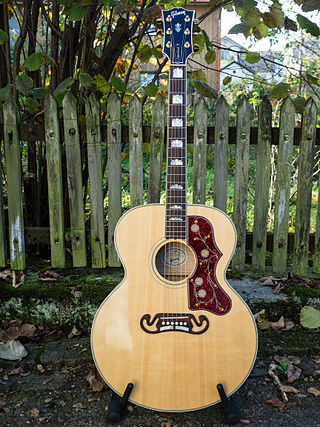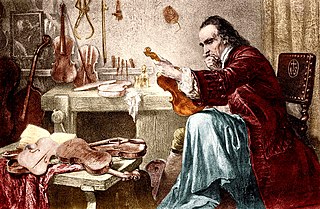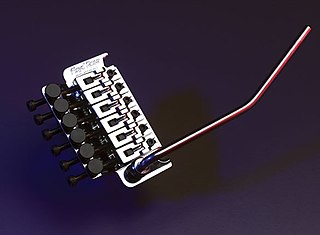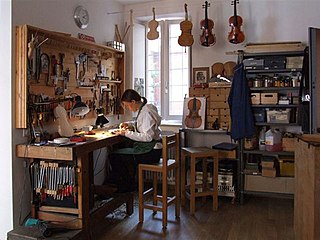Related Research Articles

The steel-string acoustic guitar is a modern form of guitar that descends from the gut-strung Romantic guitar, but is strung with steel strings for a brighter, louder sound. Like the modern classical guitar, it is often referred to simply as an acoustic guitar, or sometimes as a folk guitar.

The bass guitar, electric bass or simply bass is the lowest-pitched member of the guitar family. It is a plucked string instrument similar in appearance and construction to an electric or acoustic guitar, but with a longer neck and scale length, and typically four to six strings or courses. Since the mid-1950s, the bass guitar has largely replaced the double bass in popular music.
A mandolin is a stringed musical instrument in the lute family and is generally plucked with a pick. It most commonly has four courses of doubled strings tuned in unison, thus giving a total of eight strings. A variety of string types are used, with steel strings being the most common and usually the least expensive. The courses are typically tuned in an interval of perfect fifths, with the same tuning as a violin. Also, like the violin, it is the soprano member of a family that includes the mandola, octave mandolin, mandocello and mandobass.

Antonio Stradivari was an Italian luthier and a craftsman of string instruments such as violins, cellos, guitars, violas and harps. The Latinized form of his surname, Stradivarius, as well as the colloquial Strad are terms often used to refer to his instruments. It is estimated that Stradivari produced 1,116 instruments, of which 960 were violins. Around 650 instruments survive, including 450 to 512 violins. His instruments are considered some of the finest ever made, and are extremely valuable collector's items.

The Floyd Rose Locking Tremolo, or simply Floyd Rose, is a type of locking vibrato arm for a guitar. Floyd D. Rose invented the locking vibrato in 1976, the first of its kind, and it is now manufactured by a company of the same name. The Floyd Rose gained popularity in the 1980s through guitarists like Eddie Van Halen, Neal Schon, Brad Gillis, Joe Satriani, Steve Vai, and Alex Lifeson, who used its ability to stay in tune even with extreme changes in pitch. Its tuning stability comes through the double-locking design that has been widely regarded as revolutionary; the design has been listed on Guitar World's "10 Most Earth Shaking Guitar Innovations" and Guitar Player's "101 Greatest Moments in Guitar History 1979–1983."

A luthier is a craftsperson who builds or repairs string instruments that have a neck and a sound box. The word luthier is originally French and comes from the French word for "lute". The term was originally used for makers of lutes, but it came to be used in French for makers of most bowed and plucked stringed instruments such as members of the violin family and guitars. Luthiers, however, do not make harps or pianos; these require different skills and construction methods because their strings are secured to a frame.

A machine head is a geared apparatus for tuning stringed musical instruments by adjusting string tension. Machine heads are used on mandolins, guitars, double basses and others, and are usually located on the instrument's headstock. Other names for guitar tuners include pegs, gears, machines, cranks, knobs, tensioners and tighteners.

The Portuguese guitar or Portuguese guitarra is a plucked string instrument with twelve steel strings, strung in six courses of two strings. It is one of the few musical instruments that still uses watch-key or Preston tuners. It is iconically associated with the musical genre known as Fado.
Steinberger is a series of distinctive electric guitars and bass guitars, designed and originally manufactured by Ned Steinberger. The name "Steinberger" can be used to refer to either the instruments themselves or the company that originally produced them. Although the name has been applied to a variety of instruments, it is primarily associated with a minimalist "headless" design of electric basses and guitars.

The Russian guitar (sometimes referred to as a "Gypsy guitar") is an acoustic seven-string guitar that was developed in Russia toward the end of the 18th century: it shares most of its organological features with the Spanish guitar, although some historians insist on English guitar descent. It is known in Russian as the semistrunnaya gitara (семиструнная гитара), or affectionately as the semistrunka (семиструнка), which translates to "seven-stringer". These guitars are most commonly tuned to an open G chord as follows: D2 G2 B2 D3 G3 B3 D4. In classical literature, the lowest string (D) occasionally is tuned down to the C.

A tailpiece is a component on many stringed musical instruments that anchors one end of the strings, usually opposite the end with the tuning mechanism.

The octave mandolin or octave mandola is a fretted string instrument with four pairs of strings tuned in fifths, G−D−A−E, an octave below a mandolin. It is larger than the mandola, but smaller than the mandocello and its construction is similar to other instruments in the mandolin family. Usually the courses are all unison pairs but the lower two may sometimes be strung as octave pairs with the higher-pitched octave string on top so that it is hit before the thicker lower-pitched string. Alternate tunings of G−D−A−D and A−D−A−D are often employed by Celtic musicians.

An experimental musical instrument is a musical instrument that modifies or extends an existing instrument or class of instruments, or defines or creates a new class of instrument. Some are created through simple modifications, such as cracked cymbals or metal objects inserted between piano strings in a prepared piano. Some experimental instruments are created from household items like a homemade mute for brass instruments such as bathtub plugs. Other experimental instruments are created from electronic spare parts, or by mixing acoustic instruments with electric components.
Alvarez is a guitar brand founded in 1965 by the owner and distributor St. Louis Music. Alvarez manufactures steel-strings, classical guitars, ukuleles and, for a time, solid and hollow-body electric guitars and basses.
John Robert King (John) (October 13, 1953 – April 3, 2009) was a ukulele player known for his interpretation of classical music.

The English guitar or guittar is a stringed instrument – a type of cittern – popular in many places in Europe from around 1750–1850. It is unknown when the identifier "English" became connected to the instrument: at the time of its introduction to Great Britain, and during its period of popularity, it was apparently simply known as guitar or guittar. The instrument was also known in Norway as a guitarre and France as cistre or guitarre allemande. There are many examples in Norwegian museums, like the Norsk Folkemuseum and in British ones, including the Victoria and Albert Museum. The English guitar has a pear-shaped body, a flat base, and a short neck. The instrument is also related to the Portuguese guitar and the German waldzither.

Lichty Guitars is an American company based in Tryon, North Carolina, that has been making custom acoustic guitars and ukuleles since 2009. It was founded by musician Jay Lichty.

The Guitar and Lute Workshop (GLW) was a manufacturer of custom guitars, ukuleles, and period stringed instruments based in Honolulu, Hawaii between 1970 and 1976. The workshop was known primarily for the talented luthiers employed in either construction of guitars, or the musicians that taught at the workshop or that used guitars made at the workshop. Additionally, an independent piano restoration and tuning business operated above the workshop floor and studios for at least two years. The GLW was notable as a nexus of activity supporting native Hawaiian musical cultural discovery during the Second Hawaiian Renaissance of the 1970s, with key Hawaiian musicians such as Keola Beamer and Kapono Beamer gaining starts in their careers at the GLW, as well as musical instrument restoration for instruments of Hawaiian royalty, now curated by ʻIolani Palace. Additionally, the GLW's focus on traditional period stringed instruments was, in part, responsible for the resurgent interest in the viol and traditional luthierie methods within the western United States in the early 1970s.

Preston tuners or machines is a type of machine head tuning system for string instruments, named for English cittern maker John Preston and developed in the 18th century. Preston claimed to be the inventor of this design, though scholars note the originator could be the luthier John Frederick Hintz, who advertised such a mechanism as early as 1766. The tuning mechanism was also used on the German cittern known as the waldzither, and is associated with the early-20th-century instruments built by C. H. Böhm.
Mario Maccaferri (1900–1993) was an Italian luthier, classical guitarist, businessman, and inventor. He is noted for designing the guitar favored by jazz musician Django Reinhardt, and for designing plastic clothespins, plastic bath and kitchen tiles and the plastic Islander ukulele which sold millions of copies in the mid-1900s. From 1939 he lived and worked in the United States. As of 2016 his daughter Elaine still runs the family company French American Reeds Inc.
References
- ↑ Anthony Baines (1966). European and American musical instruments. Batsford. ISBN 9780907486282 . Retrieved 28 April 2013.
- ↑ Life after death: the viola da gamba in Britain from Purcell to Dolmetsch. Boydell & Brewer. 2010. pp. 147–. ISBN 978-1-84383-574-5 . Retrieved 28 April 2013.
- ↑ Hugh Belsey; Gainsborough's House Society (1988). Gainsborough's family. Gainsborough's House Society. ISBN 978-0-946511-09-9 . Retrieved 28 April 2013.